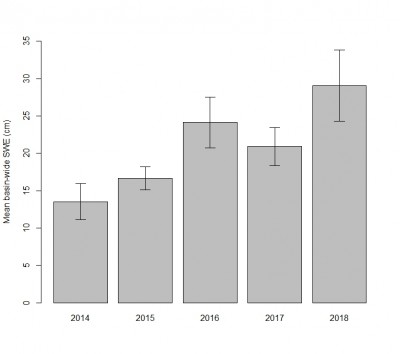Hydrology of the Apex River watershed, Iqaluit, NU
With funding from POLAR Knowledge Canada, WIRL partnered with the Nunavut Research Institute and Nunavut Arctic College Environmental Technology Program partnered as well as researchers from Queen’s University and Environment and Climate Change Canada to conduct a three-year pilot project on water science research and training in the Niaqungut (Apex) River watershed. Activities include measurement and modelling of water quality and quantity, with a major focus on accurate determination of the annual, end-of-winter snow accumulation with intensive ground-based surveys.
Each April, snow surveys are conducted by numerous 2nd year ETP students over the course of 3-5 days to quantify the landscape snow water equivalent or SWE (the amount of water stored in snowpack on the landscape) prior to the spring melt period. Automated measurement of snowfall amounts is particularly challenging in Arctic tundra landscapes due to high winds, making it important to measure the end of winter SWE on the ground. These data can be used to accurately track year-to-year changes in annual snowfall, which accounts for about half of the annual precipitation in this region, and its potential longer-term changes in response to climate warming. Therefore, this partnership aims to build capacity for long-term SWE monitoring and to continue this important observation record for years to come, in support of water balance assessment and water security initiatives in the community of Iqaluit. We now have a reliable, 5-year record of end-of-winter SWE in the Apex River watershed (Figure 1)

Figure 1: Mean, basin-wide snow water equivalent for the Apex River watershed, with 95% confidence interval. These data were collected with NAC ETP students each April via multi-data snowmobile surveys.
Freshwater quality monitoring of the Niaqungut River is also being conducted, including weekly stream sampling for dissolved organic carbon and nitrogen, total nitrogen and phosphorous, and major anions and cations. NRI research staff conducted weekly enumerations of microbial indicator bacteria (total coliforms and Escherichia coli) in Apex river samples. At one nearby lake, water quality and zooplankton sampling was conducted in early July and in late September just prior to freeze-up. Zooplankton samples are enumerated for both total biomass and species composition, and measured for total mercury content. These data will be used to understand seasonal and inter-annual variability in surface water quality regimes and how they are influenced by hydrologic processes and change. Our goal is to continue these sampling efforts as part of a longer-term monitoring issue, in combination with hydrometric gauging and annual, end-of-winter snow surveys.
Finally, in 2017, POLAR funds were received to install a new micrometeorology station approximately 4 km from the community of Iqaluit, including a state-of-the-art Eddy Covariance (EC) system for measuring water, energy and carbon dioxide exchange over the tundra ecosystem. The EC system is currently operational and is filling an important data gap for this region of Canada’s eastern Arctic.
